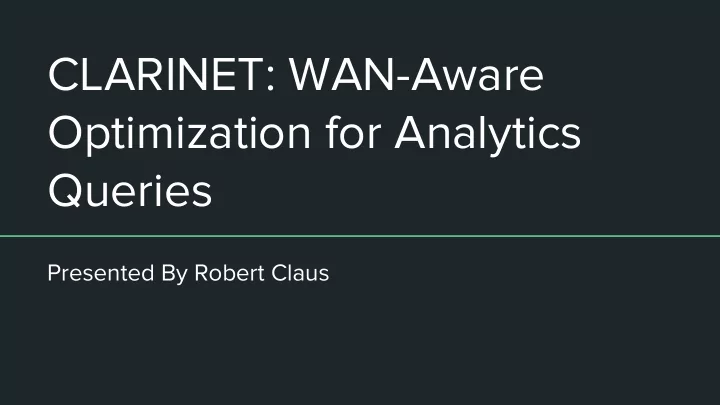

CLARINET: WAN-Aware Optimization for Analytics Queries Presented By Robert Claus
Agenda 1. The Problem 2. Clarinet 3. Optimizing WAN Queries 4. Results
Agenda 1. The Problem 2. Clarinet 3. Optimizing WAN Queries 4. Results
Low Application Latency Requires Localized Servers Servers must be close to clients for latency. Wide Area Networks (WANs) are necessary. Collecting data into a central datastore for analytics is costly and slow.
Geode Focused On Execution Previous work focused on executing queries smartly. Caching / Sending Deltas Choosing efficient distributed join algorithms Minimizing bandwidth rather than optimizing performance Allowing servers to adjust their sub-query execution plans
Wide Area Networks Are Heterogeneous Sites may have different data available. Links vary by 20x in latency. Link properties are relatively constant. Bandwidth is finite.
Example Query Planned Sub-optimally Select Results Hash Join Results
Central Planning Is Necessary Execution plans limit flexibility during execution. Need to consider the network before the execution plan.
Agenda 1. The Problem 2. Clarinet 3. Optimizing WAN Queries 4. Results
Clarinet Focuses on Planning Clarinet adds network considerations into logical query plan optimization . Allows global optimization across queries. Introduces optimizations not possible at execution stage. Optimize execution time rather than resource usage.
Combining Optimization and Scheduling
Agenda 1. The Problem 2. Clarinet 3. Optimizing WAN Queries 4. Results
Optimizing WAN Queries Is Hard There are too many options to optimize in absolute terms Breaking queries into sub-queries Where each subquery will be run How each subquery will be run Network properties are a shared resource across all queries
Heuristic Optimization Algorithm 1. Assign where tasks run first: a. Place tasks with no dependencies (Mappers) where the data is. b. Just optimize where dependant tasks (Reducers) run based on network capacity. i. Also consider just putting all reducers on the node with the most mappers. 2. Estimate how long each DAG should take: a. Insert “shuffle” nodes into the DAG whenever data is moved over the network. i. Network properties ii. Currently running tasks b. Calculate the total length the DAG will take using a LP.
Example Query Planning Broadcast Join Hash Join Select A=1 Select A=1 Select A=1 Scan CS Scan SS Scan WS
Assign Mappers Broadcast Join DC3 Hash Join Select A=1 DC2 DC1 Select A=1 Select A=1 Scan CS Scan SS Scan WS
Compress Compute Operators Broadcast Join Hash Join DC3 Work DC2 Work DC1 Work
Compress Compute Operators Broadcast Join On what server do these operators take place? Hash Join DC3 Work DC2 Work DC1 Work
Compress Compute Operators Broadcast Join On what server do these operators take 100 Gbps to DC1 place? or 40 Gbps to DC2 Hash Join 200 GB 200 GB DC3 Work OR 80 Gbps 80 Gbps DC2 Work DC1 Work
Compress Compute Operators Broadcast Join On what server do these operators take 100 Gbps to DC1 place? or 40 Gbps to DC2 Hash Join 200 GB 200 GB DC3 Work OR 80 Gbps 80 Gbps DC2 Work DC1 Work
Shuffle Operators Data on Data on Server 1 Server 2 Operation on Operation on Shuffle Operator Server 1 Server 2 This operation’s cost can be estimated from the volume of data and network bandwidth.
Introduce “Shuffle” Operators Broadcast Join 100 Gbps Hash Join 80 Gbps DC3 Work DC2 Work DC1 Work
Compute Cost Estimate 120s Broadcast Join 100 Gbps 60s 180s Hash Join 80 Gbps DC3 Work 120s 120s 60s 60s DC2 Work DC1 Work
Dynamically Scheduling Resources Allow scheduling tasks from any of the next k queries if resources available. Efficiently uses available resources. k must be tuned to avoid over-scheduling tasks with no dependencies. Queries selected based on relative deadline proximity.
Agenda 1. The Problem 2. Clarinet 3. Optimizing WAN Queries 4. Results
Running Time Improved
Network Usage Improved
Other Performance Features Multi Query Optimization 60% of queries run in batches ended up with different plans. Resource Fragmentation Network links are fallow less than 3% of the time. Optimization Time Approximately 10 seconds
Questions?
Recommend
More recommend